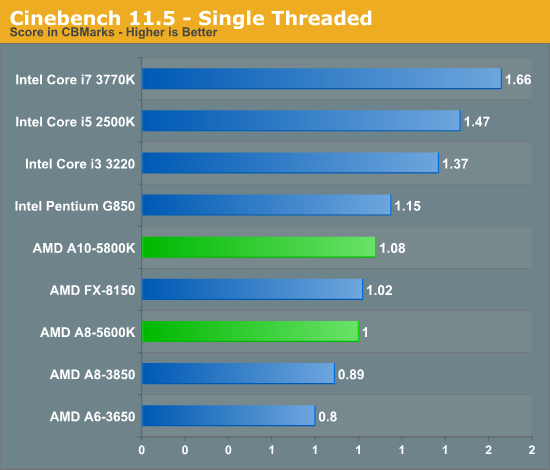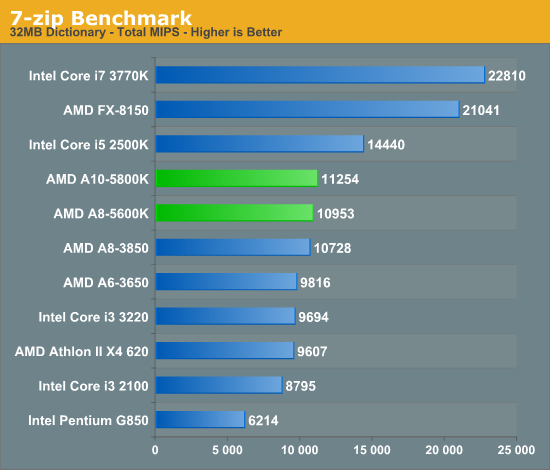AMD A10-5800K & A8-5600K Review: Trinity on the Desktop, Part 2
by Anand Lal Shimpi on October 2, 2012 1:45 AM ESTTrinity CPU Performance: The Good and the Bad
We're going to start our performance investigation a little out of order. The big question on everyone's mind is how much single threaded performance has improved over Bulldozer, and whether it's enough to actually make Trinity faster than Llano across the board. We'll use Cinebench 11.5 as it has both single and multithreaded test options:

The good news is that single threaded performance is definitely up compared to Llano. Piledriver likely has some to do with this, but so does the fact that the A10 can run at up to 4.2GHz (~4GHz typically) with one of its cores active compared to the 2.9GHz clock speed of the A8-3850. Compared to the Bulldozer based FX-8150 there's a slight (~6%) increase in single threaded performance. Although I don't expect anyone will be cross shopping a Trinity APU and a FX CPU, it's important to keep an eye on progress here as we'll eventually get a high-end quad-module/eight-core Piledriver CPU.
Note that compared to even previous generation, low-end Intel CPUs without turbo there's a huge gap in single threaded performance. If we look at the gap AMD has to make up vs. Ivy Bridge it's not pretty. Intel's Core i3 3220 manages a 27% performance advantage over the A10-5800K. Even if Steamroller is able to deliver a 15% increase in performance at the same clock speed, there will still be a gap. And we're not even talking about how Haswell will grow this gap. For the foreseeable future I don't see AMD closing the single threaded performance gap. Jim Keller's job is to fix this problem, but it'll probably take 2 - 3 years to get there.

The multithreaded test shows the other end of reality: in heavily threaded foating point workloads it's possible that we'll see a regression compared to Llano. Remember the Bulldozer/Piledriver architecture prioritizes integer over floating point performance. Truth be told this regression is pretty rare in our tests, but until we get to Steamroller we will still see these types of situations.
Throw more threads at the problem and even with a floating point workload Intel can't pull ahead however. The A10 offers similar performance to the Core i3 3220 at a lower price. Your decision here would come down to the rest of the factors: single threaded performance, processor graphics performance, overclocking capabilities and power consumption. Intel and AMD both win two of those each, it's really a matter of what matters most to you.
A heavily threaded FP workload doesn't really play to AMD's advantages though, what happens when you get a heavily threaded integer workload however? The 7-zip benchmark gives us just that:

Here AMD manages a 16% performance advantage over the Core i3 3220. I'd even go as far as to say that Trinity would likely beat any dual-core Intel machine here. The performance advantage is somewhat artificial as Intel purposefully removes turbo from its dual-core desktop CPUs. This should be AMD's best foot forward, but once again it'll likely take Steamroller for this design to start to make sense.
Speaking of artificial product segmentation, one major feature Intel takes away when you get down to the dual-core desktop i3 level is AES-NI support. Hardware accelerated AES support is something that you get only with the more expensive Core i5/i7s. With Trinity, you get AES-NI support for the entire stack. The result is much better performance in those applications that depend on it:

Like most of the advantages we've talked about thus far, there are really very specific use cases where Trinity makes sense over a similarly priced Intel CPU.










178 Comments
View All Comments
Kaggy - Saturday, October 6, 2012 - link
It would be nice to see some benchmarks on HTML5 and video playback load on the browsers, since nowadays people spend lots of time on their browsers.Silverbuckle - Saturday, October 6, 2012 - link
It looks to me that we are seeing a race to the bottom, and Intel isn't playing. After seeing the results, if I have to start with entry level computer (what ever that means today) the best course would be Intel, i3 with a z77 chip set and a modest card.I have to update one of two computers. The older one will be replaced by this one running the Athlon IIx4 630, stock (It didn't OC worth a damn). It runs CS6 very well. So for my seat, I'll build a new box. I've been waiting to see what to follow. I have two cards available Ati 5670 and Ati 7750. So I can with no additional cost, run the 7750. That makes Intel the only game, because even if I have to lo ball the price, the i3 will equal or surpass the Trinity, using the card. I can upgrade any time all the way to i7 K series.
Given the price of the card if you must include it, you are still positioned well to upgrade the computer with a simple exchange of the processor. Not so for several years with AMD, (best guess here).
Waiting was ok, even though my gut was to go Intel. What I learned is to not be afraid to include the lowly i3.
Chipman1969 - Monday, October 8, 2012 - link
Please redo some of the Trinity benchmarks with 1866 or 2133 ddr3 ram.See http://www.phoronix.com/scan.php?page=article&...
There you can see that Trinity is doing much better with faster ram.
On Amazon G.Skill Ripjaws X DDR3-1600 is 42$ and 2166 is 52$.
medi01 - Tuesday, October 9, 2012 - link
So:"Although likely not the target market for someone buying a Trinity APU, we looked at performance of AMD's latest APU when paired with a high-end discrete GPU. The end result is a total loss for Trinity."
brand new way to piss on AMD's cookies, by Anand The Shameless...
sdoraisw - Friday, January 4, 2013 - link
If you want to compare the idle numbers you should disable the Gfx in IVB processor because trinity doesn't have integrated graphics.not just disable, you need some BIOS switch to power gate the Gfx engine completely. then you can do comparisons.
x7y9 - Saturday, January 12, 2013 - link
I just got a Toshiba S875D-S7350 laptop with AMD A10-4600M processor and tried somesimple benchmarks -- the result was pretty disappointing. Running 4 identical processes
(Ubuntu 12.04) causes the completion time of each process to degrade substantially.
I do some work with generating graphs and analysing them, so basic integer performance
is the most important thing for me.
I ran this simple benchmark and the comments show the results I got:
#!/usr/local/bin/ruby -w
# M1 -- AMD Phenom 2 X4 945 Quad core desktop
# M2 -- Intel Core i3-2310M HP laptop
# M3 -- Toshiba S875D-S7350 laptop with AMD A10-4600M
# M4 -- HP AMD A6 3400M Quad core CPU 1.4-2.3 GHz
# Machine M1 M2 M3 M4
# -------------------------------
# Single run: 158 178 234 292
# 2 parallel: 169 195 283 313
# 4 parallel 205 241 642 354
# (All times in seconds; averaged over the parallel runs)
start = Process.times
a=(0..11).to_a
cnt = a.permutation.inject(0) { |m, _| m + 1 }
finish = Process.times
user = finish.utime - start.utime; sys = finish.stime - start.stime
puts "cnt = %d, user = %ds, sys = %ds" % [cnt, user, sys]
------------------------------
Needless to say, I returned the Toshiba.
.
bomer08 - Tuesday, October 15, 2013 - link
Hello, I would like to know which configuration was used for the 3220 I3. Motherboard, HD (ssd?), RAM, Graphic ... If you have changed something in the BIOS. thanksrobytzel - Thursday, December 26, 2013 - link
hello guys, i have a big question, i own a8-5600k, along with 8gb ddr3 1600mhz, my question is why does my computer lag, but really really lag in games on facebook like farm heroes saga???i cannot explain it to myself, why i can run even crysis 2 on medium-high, but cannot run normally a stupid flash player game!!!please help.happy hollidays!